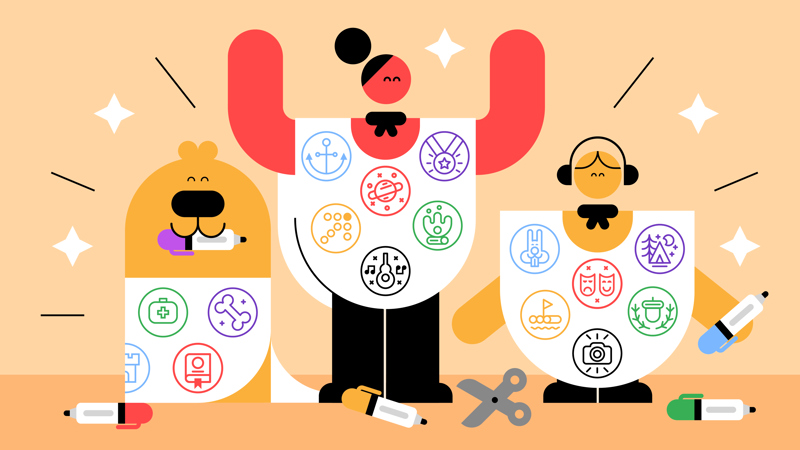
Create a camp blanket
You’ll need
- Pens or pencils
- Paint brushes
- Scrap card
- Rulers
- A4 paper
- Fabric scissors
- Coloured fabric markers
- Camp blankets
- Scout badges
- Example of a camp blanket
- Embellishments, such as buttons, sequins and so on
- Fabric glue
- Needles
- Thread
- Pins
- Pin cushion
- Chalk
Before you begin
- Use the safety checklist to help you plan and risk assess your activity. Additional help to carry out your risk assessment, including examples.
- Make sure all young people and adults involved in the activity know how to take part safely.
- Make sure you’ll have enough adult helpers. You may need some parents and carers to help if you’re short on helpers.
Setting up the activity
- People could bring in a camp blanket from home to use, or you may be able to afford or get funding to buy one for each person to use. It could even be a big t-shirt or hoodie.
- Wool blankets tend to be popular, last a long time and keep people warm.
- Ask everyone to bring in any badges they’d like to sew on.
- Always avoid using the blankets near campfires or naked flames, due to fire risk.
- Remind and watch younger Scouts not to put small items or paintbrushes in their mouths, noses, ears or similar.
- You may want to run this activity over several weeks.
Make a camp blanket
- Gather everyone together and ask if anyone has heard of a camp blanket. They’re great for keeping warm on a chilly evening.
- If any volunteer has brought their camp blanket, they could show it to the group. They could show people some of their favourite badges and explain what they mean. They probably won’t be able to explain all of them if there are lots, but people could ask about the ones they think look interesting.
- Ask everyone why they think camp blankets can be important. Tell everyone that they can create a sense of community, give people a sense of a shared history and story, and they’re collections of memories of adventures and friends.
- Explain to everyone that they’re going to make their own camp blanket. Make sure an adult is supervising anyone using the scissors, glue, or needles and thread.
- Let everyone know what materials they have access to. You can have different spare fabrics and embellishments for people to use, such as buttons, fabric offcuts or sequins. People may want to bring their Scout badges.
- Everyone should take their blanket and a piece of paper.
- Let people draw their design out on the paper before they start making the blanket, so they know what it should look like.
- If people are cutting out fabric shapes, they could use chalk to draw the shape out onto the fabric before cutting it out.
- For younger groups, they could cut out and use fabric glue to attach different things to their blankets, such as their Scout badges or fabric shapes.
- For older groups, they could use fabric glue or they may want to sew items on. If people are sewing, they may want to use pins to hold the fabric in place while they sew.
- If people are sewing, you may want to run a sewing session the week before to help everyone learn to sew and know what to do.
- Depending on the colour and the material, you may be able to use fabric pens or fabric paints to decorate the blanket.
- When everyone is finished, ask everyone to hold up their blankets and show each other their creations.
Reflection
This activity was all about designing a camp blanket.
Wearing a camp blanket is a special thing; it shows that a person belongs to a worldwide family of Scouts. When people leave a section to move on, a camp blanket can help them remember the fun they had and the friends they made.
Everyone got to design their blanket however they wanted. They may have used a needle and thread, or they could have used fabric glue. What did you choose and what were your ideas behind your design? Ask some people to talk through some of the favourite badges or designs on their blankets.
Are there any badges people would like to get for their blanket? This would be a great time to chat about ideas for future meetings.
Safety
All activities must be safely managed. You must complete a thorough risk assessment and take appropriate steps to reduce risk. Use the safety checklist to help you plan and risk assess your activity. Always get approval for the activity, and have suitable supervision and an InTouch process.
- Scissors
Supervise young people appropriately when they’re using scissors. Store all sharp objects securely, out of the reach of young people.
- Flammable items
Always take care when using flammable items, especially if you’re near fire. Always follow the manufacturer’s instructions and guidelines.
- Glue and solvents
Always supervise young people appropriately when they’re using glue and solvent products. Make sure there’s plenty of ventilation. Be aware of any medical conditions that could be affected by glue or solvent use and make adjustments as needed.
- Sharp objects
Teach young people how to use sharp objects safely. Supervise them appropriately throughout. Store all sharp objects securely, out of the reach of young people.
- Hot tools
Tools, such as irons and glue guns, produce a lot of heat. Never touch the hot metal parts. Use them under adult supervision and on a suitable surface, protecting it if necessary. Never leave hot tools unattended and be careful near combustible materials such as wood, textiles, or paper. Make sure there’s a fire extinguisher and a first aid kit (with items to treat burns) nearby. Always follow the manufacturer’s instructions for proper use. You may need to use gloves and safety goggles with glue guns.
- Electrical equipment
Inspect cables for any damage before each use. A responsible adult should supervise people using equipment, and people should follow instructions on how to use them correctly and safely. They should be properly maintained and stored. Be extra cautious of trailing cables and water when using electric equipment.
- To make this activity easier, you could also use iron-on patches. Make sure only adults uses the iron, the iron is always supervised by an adult, an iron board and heatproof ironing board cover is used, and the iron is unplugged and left to cool on a heatproof surface that’s out of reach of young people.
- Let everyone know you’ll be doing some sewing before your meeting, so that anyone who wants to can practice beforehand.
- People could use needle threaders or bigger needles if this would make the activity work for them. You may want to have some needles pre-threaded to help people.
- This activity can be done sitting or standing, either on the floor or on chairs. Make sure to adapt to whichever way works best for everyone and make sure any actions are things everyone can do.
- Make sure that all the materials are at a level that can be easily worked on by wheelchair users.
- Some arts and craft activities may involve touching certain textures or items or involve getting messy. People should only do this if they’re comfortable too. People could wear plastic gloves if they don’t like the feeling of a certain material on their hands. They could also use another method of being creative, such as decorating a necker or flag, rather than a wool blanket.
All Scout activities should be inclusive and accessible.
You could start a group camp blanket with badges that everyone has. You could even make a blanket by sewing together several of your group scarves, or you could make a mini camp blanket for a teddy or group mascot.
This activity is a great chance for everyone to think about the badges they’d like towards and try to work this into their future programme.

